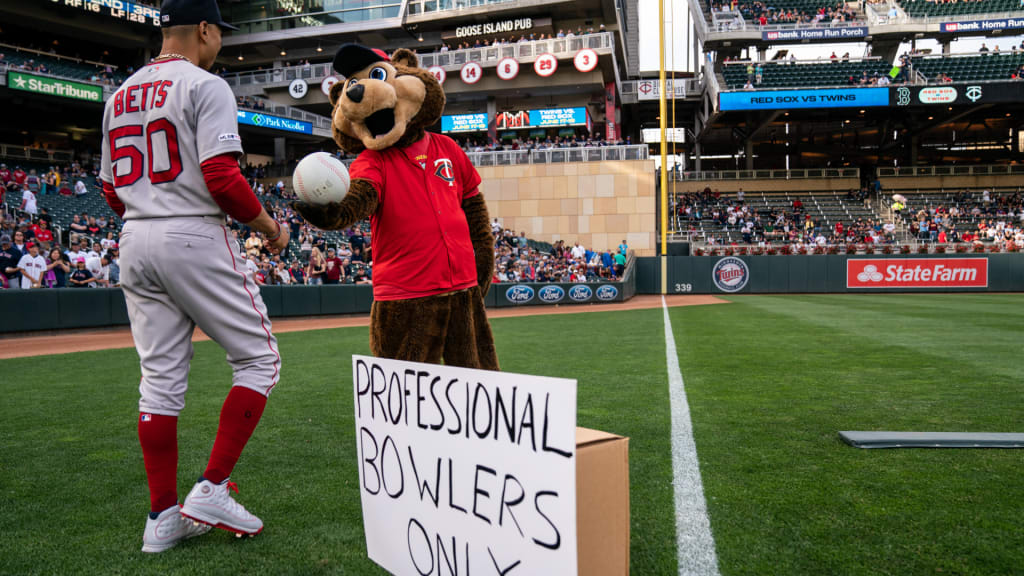MINNEAPOLIS -- He usually gets the better of fans in softball home run derbies, brings joy to children at birthday parties and hospital visits around Twins Territory, wields a wholesome (and sometimes funny) Twitter account, never turns down a good photo op, and waves a big Twins flag around the ballpark.
He's team mascot T.C. Bear, and it's tough to imagine a Twins game without him acting out his personalized gestures for each player as starting lineups are announced or strolling around the ballpark, butting his massive grin into fan pictures.
"T.C. Bear, as far as kids are concerned and everything, I think it's a really nice mascot," Twins historian and team curator Clyde Doepner said. "I always kidded him, 'You take good pictures, you always have a perfect smile, you know?' And I really think it's positive. We've had him out for kids' birthday parties, where you hire him out to come to a birthday party. And the kids love running up, and they do a nice job. They really do. It's a good, positive image for the Minnesota Twins."
But why is he a bear? Why not, say, a set of twins, as the team name might suggest, or an animal with more significance to the state of Minnesota, like a loon (or, perhaps more jokingly, a mosquito)?
Somewhat more fittingly, the Twins did briefly have another mascot named Twinkie the Loon from 1980-81, long before T.C. Bear made his debut in 2000. Twinkie was, well, a sight to behold. He had skinny black legs, a torso with black and white feathers, a big orange beak, huge eyes and a massive red Twins cap. He would juggle various items and ride on a unicycle around Metropolitan Stadium.
But that's a story for another time.
What's relevant here to the T.C. story is that former manager Gene Mauch was a staunch baseball traditionalist, Doepner explained, and the skipper didn't quite appreciate the juggling avian and its antics distracting from the serious business of baseball on the field. The costume was falling apart after two seasons, anyway, and Twinkie the Loon didn't move to the Metrodome with the team. That left the club without a mascot for nearly two decades.
Doepner recalled that the advent of bobbleheads in Major League Baseball in 1999 -- including the wildly successful Willie Mays bobblehead giveaway by the Giants -- helped to spur the Twins' desire for more such fan engagement. After four well-received bobblehead giveaways, Doepner said the Twins' leaders decided to bring a mascot back into the fray for everyday fan engagement.
"It was at a time where the Twins were trying to come up with ideas to give fans something to look forward to besides just the game," Doepner said.

Several different options were considered, with some derived from promotions or stuffed animals, including wolves, raccoons and bears, according to Doepner, as well as a less defined creature he could only describe as "a bigfoot or whatever." Various advertising groups and some fans were asked for their inputs as the discussion ensued among Twins leadership figures. For example: Would a wolf mascot scare children too much?
"They wanted something kid-friendly, and of all the things you can get, you can have a wolf howling, I suppose," Doepner said. "You can have a loon who's making its wonderful sound, and all the other things you can do. And I think the friendly bear just really kind of fell into place."
How, then, would they make the bear appear friendly?
As it turned out, that was the easy part, with a little bit of local inspiration.
Those that have lived in Minnesota for several decades will no doubt remember the commercials and strong Twins presence of Hamm's Brewery, a St. Paul-based manufacturer that advertised its beer during the late 20th century with whimsical television commercials starring a cartoon bear named Sascha, set to the folksy tune of the song, "From the Land of the Sky-Blue Water." Hamm's had a particularly close association with the Twins, with a financial stake in helping the franchise relocate from Washington to Minnesota.
"That was even part of the plus of [Calvin Griffith] moving here -- he got Hamm's Beer to pay for the announcers," said Doepner, who was close to the Griffith family. "Any way he could save a dollar."
So, when the Twins needed a happy-go-lucky bear of their own, there was little question of where to look. The resemblance is clear. Not only was T.C. Bear an immediate hit (as portrayed by gentle giant Greg Wilfahrt for most of its existence), but the design also paid tribute to one of the club's oldest sponsors and an iconic local brand. The Twins haven't looked back since then.
"When they picked T.C. Bear, I think there was a real strong influence where he's remarkably close to that [Hamm's] bear," Doepner said. "In other words, if you want a happy-go-lucky bear, you almost have to go that direction. And so that's how they that's how they ended up with T.C. Bear. They just ended up with that likeness. And he became famous."
